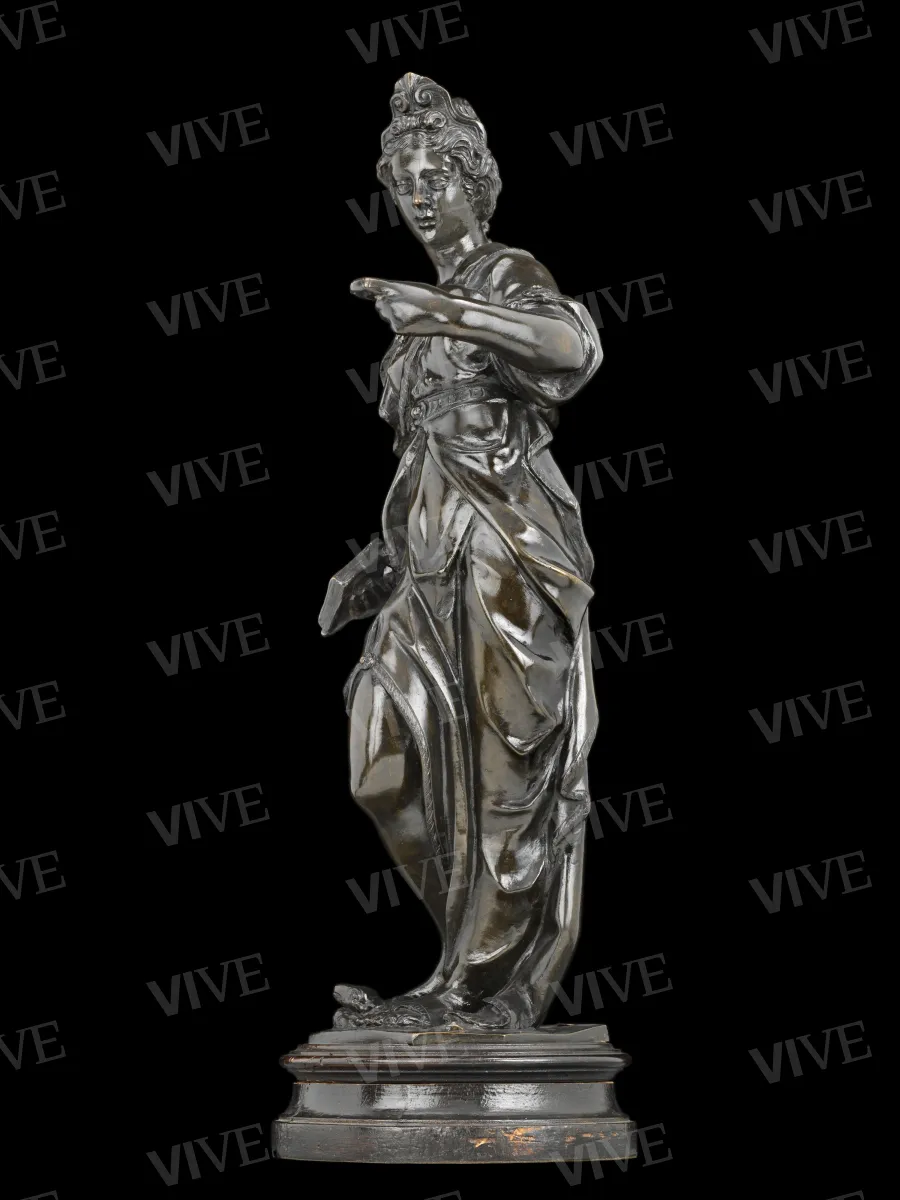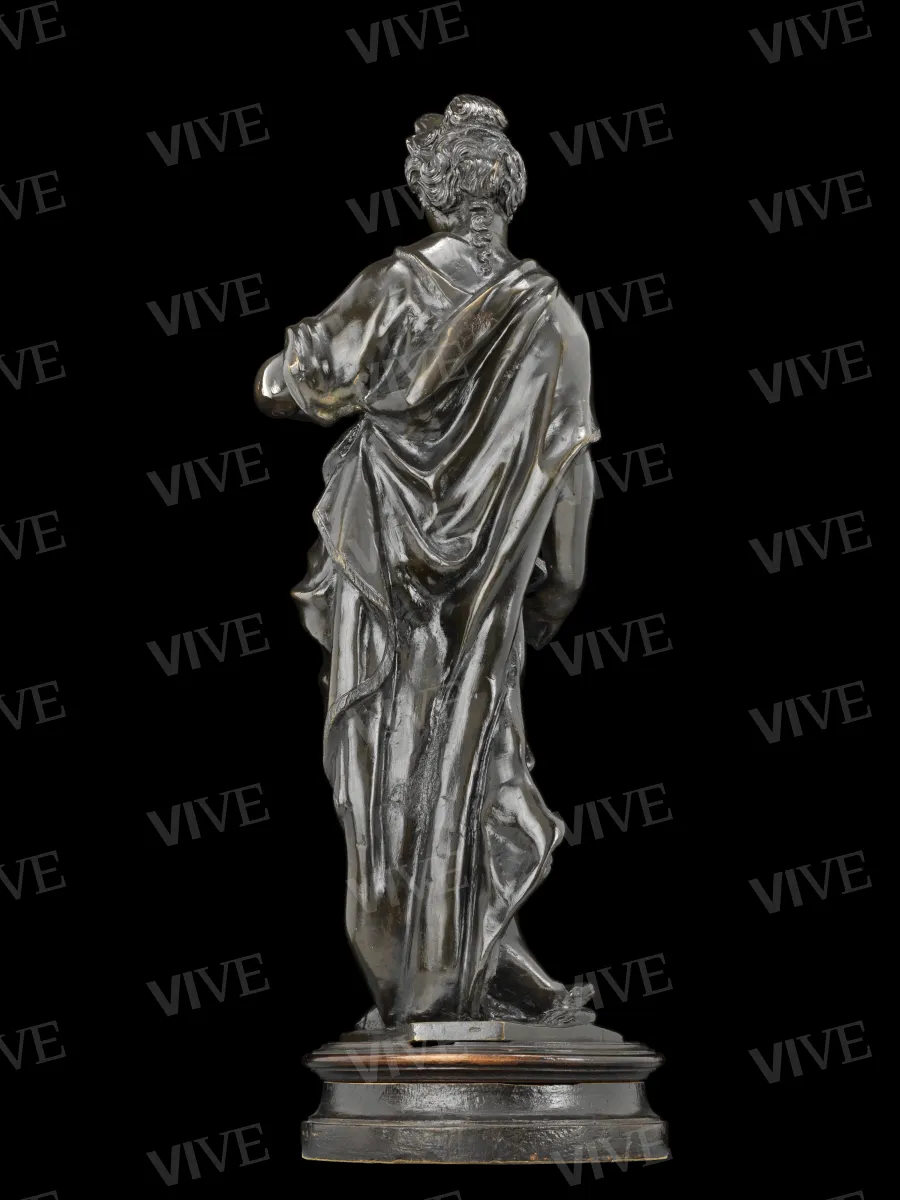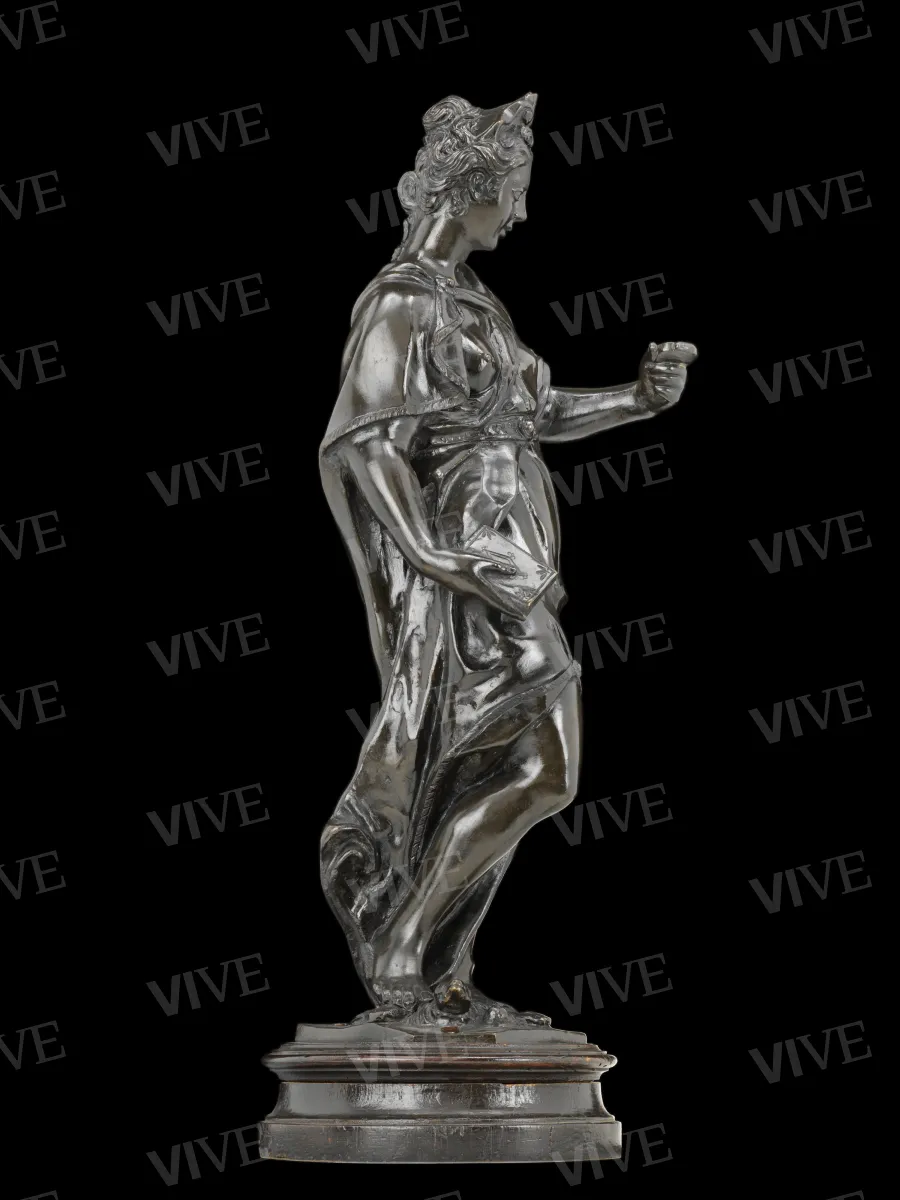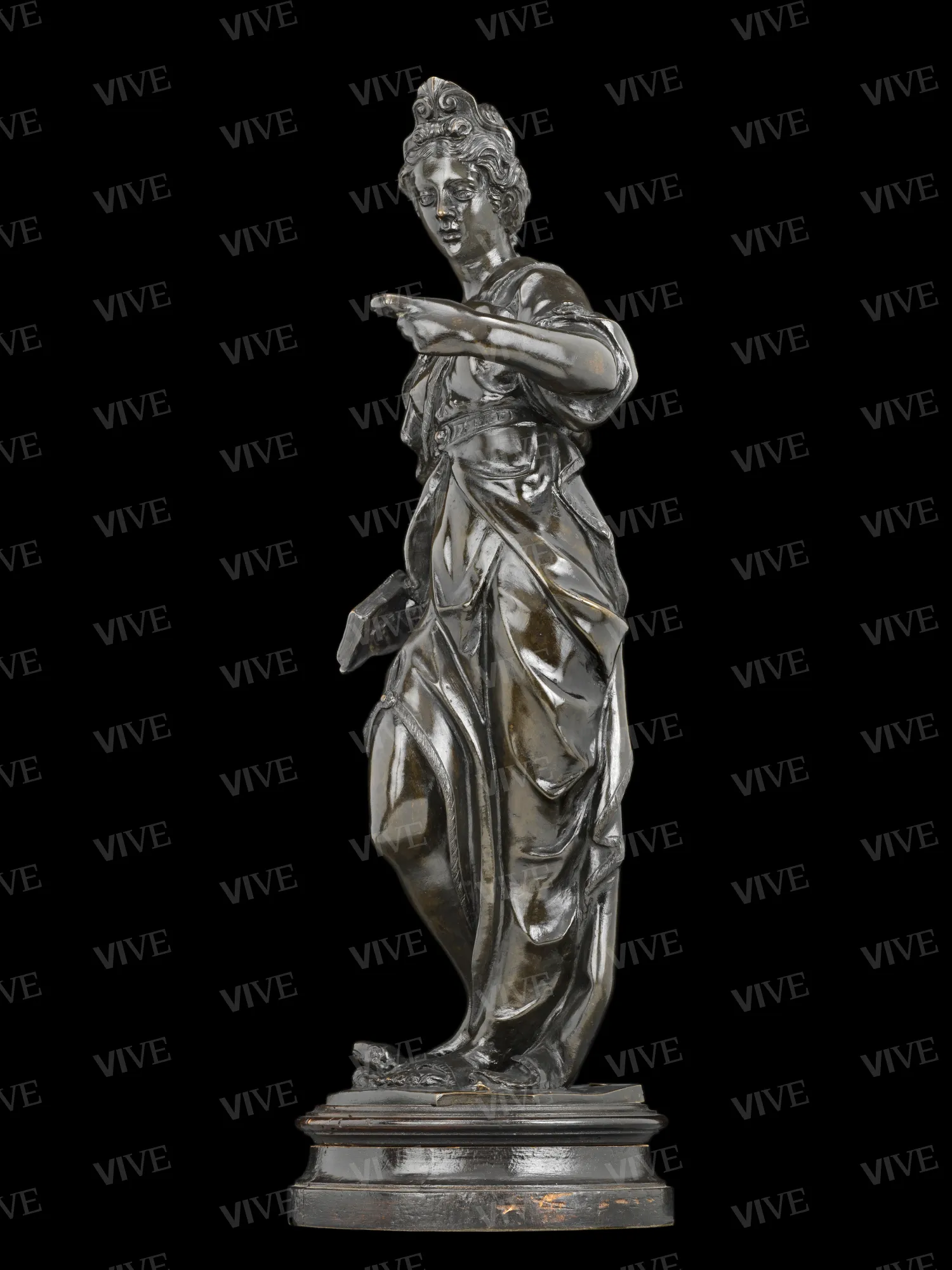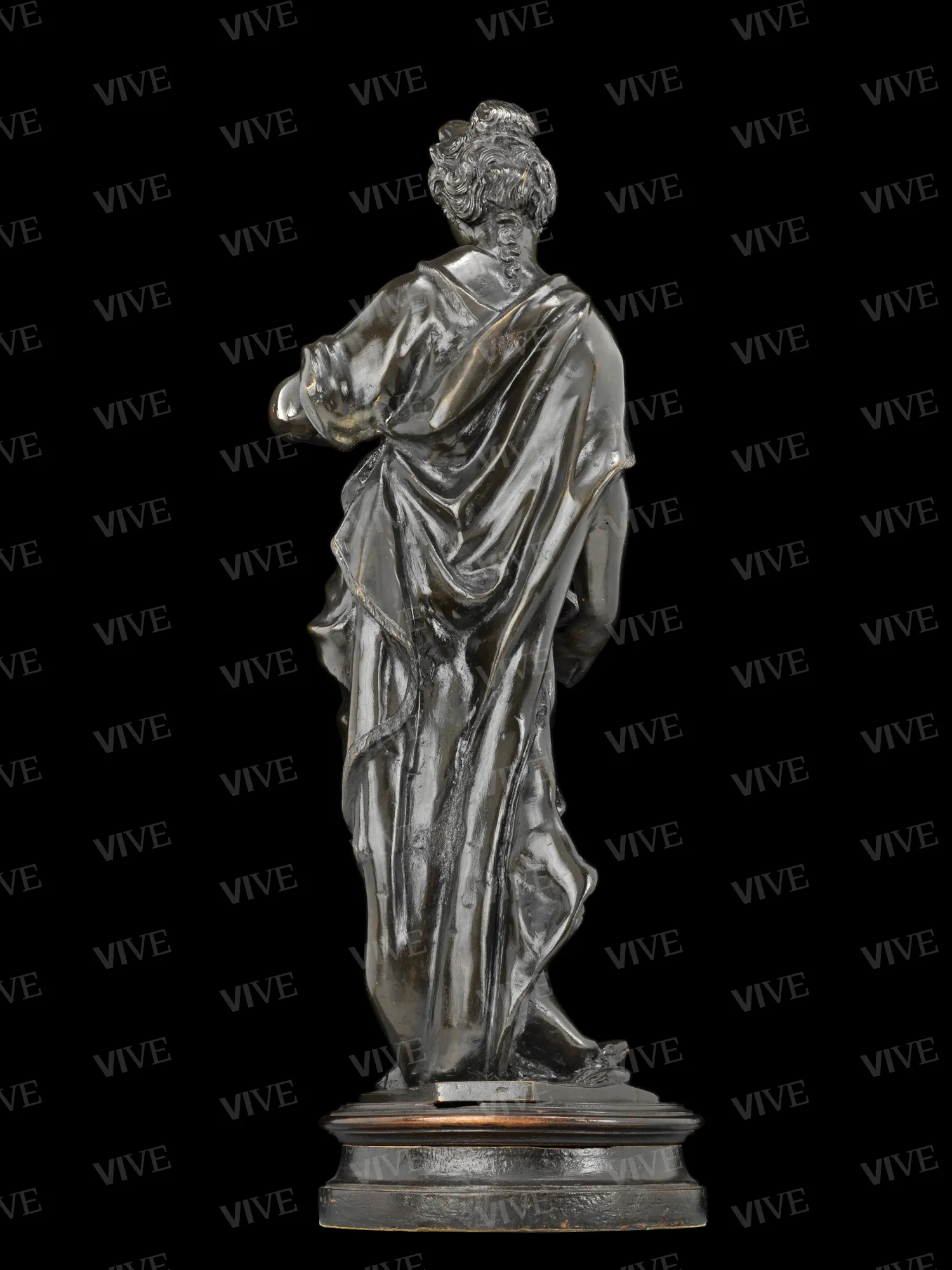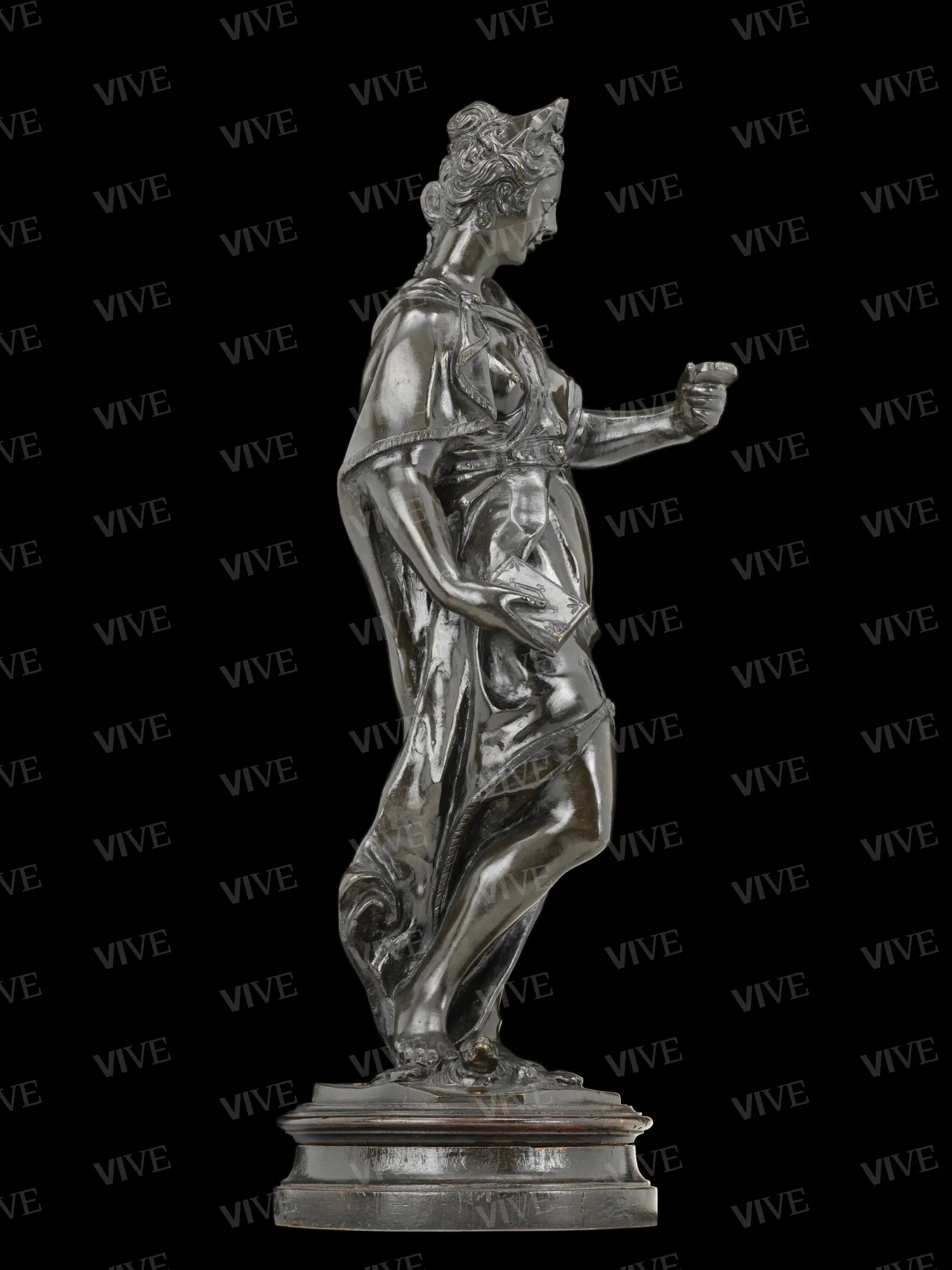Allegorical figure with book and turtle (Temperance–Modesty)
Tiziano Aspetti 1590–1599
The female figure stepping on a turtle is believed to represent a Virtue, likely Temperance–Modesty. This artwork was created by Tiziano Aspetti in the late sixteenth century while he was in Padua working on bronze statues for the Basilica of Saint Anthony.
The female figure stepping on a turtle is believed to represent a Virtue, likely Temperance–Modesty. This artwork was created by Tiziano Aspetti in the late sixteenth century while he was in Padua working on bronze statues for the Basilica of Saint Anthony.
Details of work
Catalog entry
The attribution of this small bronze to the Paduan sculptor Tiziano Aspetti (Padua, before 1555–Pisa 1606), nephew of the artist of the same name Tiziano Aspetti, known as Minio (Padua, c. 1507–1552), was established in the early 1960s (Pope-Hennessy 1961; Van Schendel 1961; Moriondo Lenzini, Berti 1962). Initially thought to be a small-format version of the statues of the Cardinal Virtues in the Basilica of Saint Anthony in Padua, Pope-Hennessy (1963; 1968) later distinguished this bronze from the Basilica sculptures. Although there are no compositional or iconographic connections with the sculptures of the saint, it is considered plausible that the work dates to a chronological period close to these, specifically the last decade of the sixteenth century. There are several examples, including one at the Worcester Art Museum (Bulletin 1919, in the “manner of Alessandro Vittoria”), at the Museo Civico Amedeo Lia in La Spezia (Avery 1998), in the Vok collection in Padua (Banzato 2004), in the Böhler collection in Munich (Böhler 1978), and at Michael Hall Fine Arts Inc. in New York (Notable Works 1967). Other notable examples include one in the Galli collection in Carate Brianza, one sold at a Paris auction (Palais Galliera) on April 9, 1976 (Banzato 2004), one at the Gotha Museum (Böhler 1978), and one for sale in Florence on June 16, 2022 (Pandolfini 2022). The small bronze in the Museo di Palazzo Venezia originates from the Viennese collection of Giacinto Auriti (Santangelo 1964). The identity of the subject remains uncertain due to the loss of the attribute that the figure originally held: currently, only an oval disc is visible, which has been identified either as a host or the base of a chalice. This ambiguity has led to varied interpretations, with one common belief recognizing the woman as a Virtue or a religious figure. The most widely accepted theory is that she represents Faith, albeit with some reservations (Cannata 1996; Cannata 2011). Conversely, Avery (1998) postulated that she might embody Prudence, suggesting that the woman was holding a mirror. We propose a novel interpretation based on the presence of the turtle beneath the female figure's foot. In Renaissance culture, the turtle, aside from representing Earth, symbolized virtues such as Temperance and Modesty, and was also associated with the protection of virgins and marriage (Maffei 2020, 306–308; Cartari 1571, 540-542; Valeriano 1556, Italian edition 1625, 355; Ripa 1593, pp. 227, 269, 290). The animal, historically believed by ancient civilizations to be tongue-less, became a symbol of female modesty. This notion originates from a passage in Plutarch’s Coniugalia Praecepta (32), which describes Phidias’ statue of Venus Urania: “Phidias represented the Aphrodite of Eleusis with one foot on a turtle; for women, this has the exhortative meaning of staying at home and keeping silent” (Martano, Tirelli 1990, 83; see also Papini 2014, 174–178 for Phidias’ work). The modest attire of the bronze statuette, which contrasts with “that of the other female figures modeled by Aspetti” (Cannata 2011), aligns with the depiction of a chaste and virtuous virgin. Consequently, it is highly probable that the subject of the bronze statuette is Temperance–Modesty, especially when considering the common use of Renaissance hieroglyphics in sixteenth-century Paduan decorations (Pietrobelli 2022). Furthermore, we propose that the elegant movements of the figure, characterized by a serpentine pose, with one leg bent forward, the left arm lowered alongside the body, and the other raised, are influenced by the figure of Virtue in the monument by Tiberio Deciani in Santa Maria del Carmine in Padua, created around 1580 by Francesco Segala (Siracusano 2015, 85, 103, n. 71). It is plausible that Aspetti drew inspiration from the stone statue for the general pose, as both works feature the figure trampling on a turtle.
Giulio Pietrobelli
Entry published on 12 June 2025
State of conservation
Good. Black lacquer with a hexagonal bronze base on a wooden pedestal.
Provenance
Vienna, Giacinto Auriti collection, formed between 1922 and 1933;
Rome, Museo Nazionale di Palazzo Venezia, donated in 1963.
Exhibition history
London, The Victoria & Albert Museum, Italian Bronze Statuettes, July 27–October 1, 1961;
Amsterdam, Rijksmuseum, Meesters van het brons der Italiaanse Renaissance, October 29, 1961–January 14, 1962;
Florence, Palazzo Strozzi, Bronzetti italiani del Rinascimento, February–March 1962.
References
Cartari Vincenzo, Le imagini de i Dei de gli Antichi, in Venetia, appresso Giordano Ziletti e compagni, 1571;
Ripa Cesare, Iconologia overo descrittione dell’imagini universali cavate dall’antichità et da altri luoghi, in Roma, per gli Heredi di Gio. Gigliotti, 1593;
Valeriano Pierio, Ieroglifici overo Commentarii delle occulte significationi de gl’Egittij, & altre Nationi, in Venetia, presso Gio. Battista Combi, 1625;
Ricci Vincenzo, Geroglifici morali, in Napoli, per Gio. Domenico Roncagliolo, 1626
Planiscig Leo, Collezione G. Auriti. Bronzi e targhette, 1931, n. 15 (catalogo dattiloscritto segnalato in Cannata 2011, p. 111);
«Bulletin of the Worcester Art Museum», IX, January 1919, 4, p. [61];
Italian Bronze Statuettes, catalogo della mostra (Londra, The Victoria & Albert Museum, 27 luglio-1 ottobre 1961), [London] 1961, n. 165;
Van Schendel Arthur (a cura di), Meesters van het brons der Italiaanse Renaissance, catalogo della mostra (Amsterdam, Rijksmuseum, 29 ottobre 1961-14 gennaio 1962), Amsterdam 1961, n. 163;
Moriondo Lenzini Margherita, Berti Luciano (a cura di), Bronzetti italiani del Rinascimento, catalogo della mostra (Firenze, Palazzo Strozzi, febbraio-marzo 1962), Firenze 1962, n. 161;
Pope-Hennessy John, Italian Bronze Statuettes – II, in «The Burlington Magazine», 105, 719, febbraio 1963, pp. 58-71;
Santangelo Antonino, Museo di Palazzo Venezia. La collezione Auriti. Piccoli bronzi, placchette, incisioni e oggetti d’uso, Roma 1964, p. 18, tav. XIV;
Notable Works of Art Now on the Market, in «The Burlington Magazine», CIX, 777, dicembre 1967, supplemento, tav. XXVIII;
Pope-Hennessy John, Essays on Italian Sculpture, London 1968, pp. 172-198, tav. 228;
Böhler Julius, Ausstellung von Gemälden, Handzeichnungen, Plastiken in Holz, Terracotta und Bronze, Kunstgewerbe, München, September-Oktober, München 1978, n. 42;
Martano Giuseppe, Tirelli, Aldo (a cura di), Plutarco, Precetti coniugali, Napoli 1990;
Mariacher Giovanni, Aspetti (De Aspectis), Tiziano, in Allgemeines Künstler-Lexikon, München, Leipzig 1992, 5, pp. 445-447;
Cannata, in Zuraw Shelley, Barberini Maria Giulia, Cannata Pietro, et al. (a cura di), Masterpieces of Renaissance and Baroque Sculpture from the Palazzo Venezia, Rome, catalogo della mostra (Athens, Georgia Museum of Art, 5 ottobre-24 novembre 1996), Athens 1996, pp. 50-51, n. 6;
Avery, in Avery Charles, La Spezia. Museo Civico Amedeo Lia. Sculture. Bronzetti, placchette, medaglie, La Spezia 1998, pp. 169-170, n. 102;
Banzato Davide, Bronzi del Rinascimento. Collezione Vok, [Padova] 2004, pp. 78-81, nn. 26-27;
Cannata, in Barberini Maria Giulia, Sconci Maria Selene (a cura di), in Guida al Museo Nazionale del Palazzo di Venezia, Roma 2009, p. 74, n. 74;
Cannata, in Cannata Pietro, Museo Nazionale di Palazzo di Venezia. Sculture in bronzo, Roma 2011, pp. 110-111, n. 12;
Papini Massimiliano, Fidia. L’uomo che scolpì gli dei, Roma-Bari 2014;
Siracusano Luca, Per Francesco Segala “padovano scultore et architettore”, in «Arte Veneta», 72, 2015, pp. 77-105;
Maffei Sonia, Temperanza nell’Iconologia di Cesare Ripa. Tipologie e fortuna, in Ferretti, Giuliano, Roudaut, François, Dupouy, Jean-Pierre (a cura di), La Vertu de tempérance entre Moyen Âge et âge classique, Paris 2020, pp. 295-318;
Pandolfini casa d’aste. Sculture e oggetti d'arte dal medioevo al XIX secolo, catalogo di vendita (Firenze, 16 giugno 2022), asta n. A1123, pp. 48-49, n. 50;
Pietrobelli Giulio, Alcune note sulle decorazioni geroglifiche dell’Odeo Cornaro a Padova, in «Eidola», 19, 2022, pp. 117-136.

